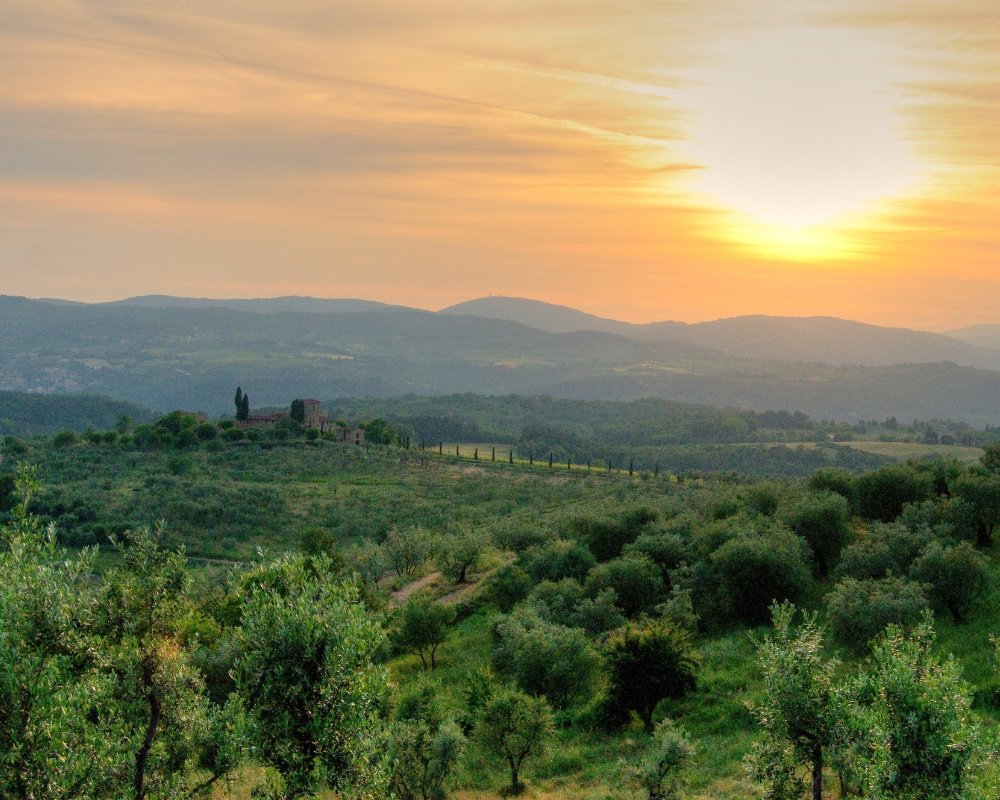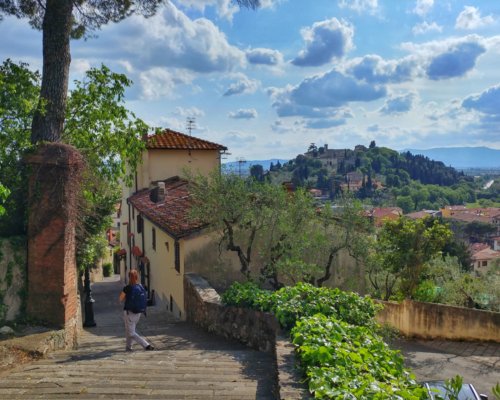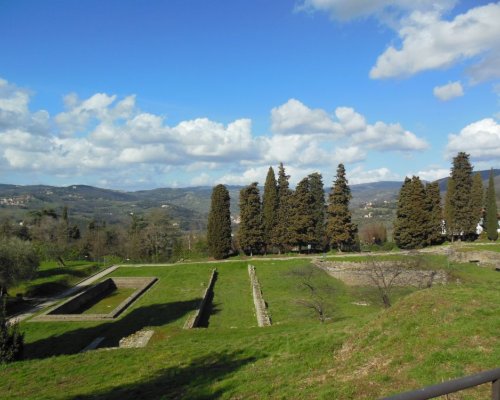Exploring the hills around the Tuscan capital
The Renaissance ring is a 250 kilometres hiking trail divided into 8 sections, with 10 variants offering some leeway in that distance. These variants range from a minimum of 5 to a maximum of 25 kilometres.
This route, which allows you to really discover Florence’s surroundings, traditionally begins and ends at the Calenzano Castle; being a circuit, however, it can of course start and finish wherever the individual chooses. The original route is truly circular in form, but the variations that have been added to it over the years have made it a little more difficult to define in terms of shape.
There are a great many points of interest along the way, including castles, country churches, historic villages and a wide variety of geography, from riverbanks to mountain peaks. The route has a medium difficulty level, with asphalt alternating with loose surfaces.
Distance: 19 km
Difference in altitude: 850 m
Traditionally, walkers would begin and end the trek at the Calenzano Castle, and the first segment of the loop wastes no time in challenging the walker. It’s almost 20 kilometres before you arrive at Vaglia, but those 20 kilometres are highly rewarding from a landscape point of view. To one side, you can see Florence; to another, you can look up to the Mugello and the Apennine mountains.
Distance: 19 km
Difference in altitude: 850 m
Traditionally, walkers would begin and end the trek at the Calenzano Castle, and the first segment of the loop wastes no time in challenging the walker. It’s almost 20 kilometres before you arrive at Vaglia, but those 20 kilometres are highly rewarding from a landscape point of view. To one side, you can see Florence; to another, you can look up to the Mugello and the Apennine mountains.
Distance: 16.2 km
Difference in altitude: 750 m
From Vaglia, you reach Fiesole by way of a ridge, which affords wide, sweeping views over Fiesole and Florence. Continue to L’Alberaccio before heading onwards to Pontassieve, through a section of the circuit that is mainly interesting for its natural features. The road to Pontassieve and the Sieve valley is almost entirely downhill, and swaddled in a beautiful landscape. Charming farmsteads poke out among the vineyards.
- Variant 2A: Bivigliano – Monte Senario
distance 1.3 km; difference in altitude: 170 m - Variant 2B: Alberaccio – Fiesole
distance: 10.7 km; difference in altitude: 375 m
Distance: 16.2 km
Difference in altitude: 750 m
From Vaglia, you reach Fiesole by way of a ridge, which affords wide, sweeping views over Fiesole and Florence. Continue to L’Alberaccio before heading onwards to Pontassieve, through a section of the circuit that is mainly interesting for its natural features. The road to Pontassieve and the Sieve valley is almost entirely downhill, and swaddled in a beautiful landscape. Charming farmsteads poke out among the vineyards.
- Variant 2A: Bivigliano – Monte Senario
distance 1.3 km; difference in altitude: 170 m - Variant 2B: Alberaccio – Fiesole
distance: 10.7 km; difference in altitude: 375 m
Distance: 15.1 km
Difference in altitude: 500 m
In this, the easternmost section of the journey, we find a number of variants. From Casabella you come to Rufina, thence taking the CAI route to arrive at Londa, the gateway to the Casentino Forest Park. The terrain here is mountainous. Pontassieve serves as a starting point for other variants: you can head towards Pelago, and then take a demanding trek to Reggello along the slopes of Pratomagno. Be prepared, then, for gentle hills to give way to something that looks like Piedmont, as if you were touching the Alps.
- Variant 3A: Londa – Rufina
distance 13.2 km; difference in altitude 800 m - Variant 3B: Rufina – Casabella
distance: 5.8 km; difference in altitude: 300 m - Variant 3C: Reggello – Pelago
distance: 24.7 km; difference in altitude: 1200 - Variant 3D: Pelago – Pontassieve
distance: 8.3 km; difference in altitude: 270 m
Distance: 15.1 km
Difference in altitude: 500 m
In this, the easternmost section of the journey, we find a number of variants. From Casabella you come to Rufina, thence taking the CAI route to arrive at Londa, the gateway to the Casentino Forest Park. The terrain here is mountainous. Pontassieve serves as a starting point for other variants: you can head towards Pelago, and then take a demanding trek to Reggello along the slopes of Pratomagno. Be prepared, then, for gentle hills to give way to something that looks like Piedmont, as if you were touching the Alps.
- Variant 3A: Londa – Rufina
distance 13.2 km; difference in altitude 800 m - Variant 3B: Rufina – Casabella
distance: 5.8 km; difference in altitude: 300 m - Variant 3C: Reggello – Pelago
distance: 24.7 km; difference in altitude: 1200 - Variant 3D: Pelago – Pontassieve
distance: 8.3 km; difference in altitude: 270 m
Distance: 12.7 km
Difference in altitude: 700 m
The road to Montecucco unfolds along old, panoramic pathways, with views over the basin of the Arno valley. As with other sections, this walk is fascinating for its ecology as much as for its historical and artistic interest.
Once you’ve climbed to Montecucco, you have a choice. You can turn right towards Bagno a Ripoli, arriving at the haunting Spedale del Bigallo, or left towards Rignano sull’Arno.
If you decide to take it, a new variant has opened in recent times, leading to San Donato in Collina. You come down the ridge to reach the composite municipality of Figline Incisa Valdarno. This variant, which is quite taxing, takes you through Poggio di Firenze, Montelepri and Poggio Tondo.
- Variant 4B: Figline-Incisa – SanDonato in Collina
distance: 25.5 km; difference in altitude: 1300 m - Variant 4A: Rignano sull’Arno – Montecucco – Bagno a Ripoli
distance 15.8 km; difference in altitude: 560 m
Distance: 12.7 km
Difference in altitude: 700 m
The road to Montecucco unfolds along old, panoramic pathways, with views over the basin of the Arno valley. As with other sections, this walk is fascinating for its ecology as much as for its historical and artistic interest.
Once you’ve climbed to Montecucco, you have a choice. You can turn right towards Bagno a Ripoli, arriving at the haunting Spedale del Bigallo, or left towards Rignano sull’Arno.
If you decide to take it, a new variant has opened in recent times, leading to San Donato in Collina. You come down the ridge to reach the composite municipality of Figline Incisa Valdarno. This variant, which is quite taxing, takes you through Poggio di Firenze, Montelepri and Poggio Tondo.
- Variant 4B: Figline-Incisa – SanDonato in Collina
distance: 25.5 km; difference in altitude: 1300 m - Variant 4A: Rignano sull’Arno – Montecucco – Bagno a Ripoli
distance 15.8 km; difference in altitude: 560 m
Distance: 18.3 km
Difference in altitude: 700 m
Linking up again with the first variation, you head towards the circuit’s most southern stretch. This takes you to Impruneta, via olive groves and vineyards, which open up to the sumptuous landscapes of the Chianti.
Distance: 18.3 km
Difference in altitude: 700 m
Linking up again with the first variation, you head towards the circuit’s most southern stretch. This takes you to Impruneta, via olive groves and vineyards, which open up to the sumptuous landscapes of the Chianti.
Distance: 7 km
Difference in altitude: 100 m
The walk from Impruneta to La Certosa is nice and easy, all downhill. You cannot put a price on the views that open up to you, whether of the city or the monumental complex of the Certosa monastery.
You can get to Florence from here. The obvious place at which you would emerge is Piazzale Michelangelo, the famous “balcony” over the city and the river Arno.
Distance: 7 km
Difference in altitude: 100 m
The walk from Impruneta to La Certosa is nice and easy, all downhill. You cannot put a price on the views that open up to you, whether of the city or the monumental complex of the Certosa monastery.
You can get to Florence from here. The obvious place at which you would emerge is Piazzale Michelangelo, the famous “balcony” over the city and the river Arno.
Distance: 21.6 km
Difference in altitude: 775 m
If you opt to remain in the hills, however, you can walk through yet more breathtaking landscapes, dotted with villas and old farmhouses, as you come to the western edge of the loop.
The path dives among the trees, pinewoods typical of the Florentine hills around the Chianti area. You pass through Pian dei Cerri, the hilliest part of the Scandicci municipality, and come to Lastra a Signa via a road that winds among the woods of Roveta. The trees alternate with olive groves, which opens up a view over the river Arno.
Crossing the Arno, you find yourself in Signa, where a new variant is available. This level road follows the course of the Arno, and indeed makes up part of the Arno cycle route. It leads you from the Renai Park to another park, the Cascine, in the centre of Florence.
- Variant 7A: La Certosa – Firenze
distance: 7.5 km; difference in altitude: 200 m
Distance: 21.6 km
Difference in altitude: 775 m
If you opt to remain in the hills, however, you can walk through yet more breathtaking landscapes, dotted with villas and old farmhouses, as you come to the western edge of the loop.
The path dives among the trees, pinewoods typical of the Florentine hills around the Chianti area. You pass through Pian dei Cerri, the hilliest part of the Scandicci municipality, and come to Lastra a Signa via a road that winds among the woods of Roveta. The trees alternate with olive groves, which opens up a view over the river Arno.
Crossing the Arno, you find yourself in Signa, where a new variant is available. This level road follows the course of the Arno, and indeed makes up part of the Arno cycle route. It leads you from the Renai Park to another park, the Cascine, in the centre of Florence.
- Variant 7A: La Certosa – Firenze
distance: 7.5 km; difference in altitude: 200 m
Distance: 15.5 km
Difference in altitude: 200 m
One more section remains before we close the circuit and end up back where we started. Hug the Renai Park, with its mirrors of water, and make for Campi Bisenzio. This stretch of the route, which goes through the so-called Florentine plain, has been laboriously drained over the years: now widely settled, it still holds a number of surprises.
Traces of the past can still be seen all the way to Campi Bisenzio, and give the area a unique quality that can only really be understood from the banks of the river Bisenzio. The final leg of this long hike takes you to Calenzano through some heavily industrialised areas, with motorways and B-roads with a lot of traffic.
- Variant 8A: Signa – Firenze
distance 12.1 km; difference in altitude 50 m
Distance: 15.5 km
Difference in altitude: 200 m
One more section remains before we close the circuit and end up back where we started. Hug the Renai Park, with its mirrors of water, and make for Campi Bisenzio. This stretch of the route, which goes through the so-called Florentine plain, has been laboriously drained over the years: now widely settled, it still holds a number of surprises.
Traces of the past can still be seen all the way to Campi Bisenzio, and give the area a unique quality that can only really be understood from the banks of the river Bisenzio. The final leg of this long hike takes you to Calenzano through some heavily industrialised areas, with motorways and B-roads with a lot of traffic.
- Variant 8A: Signa – Firenze
distance 12.1 km; difference in altitude 50 m


